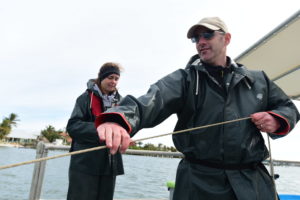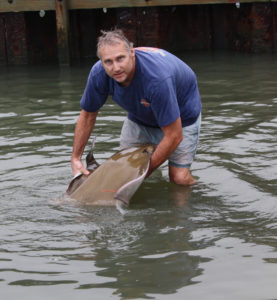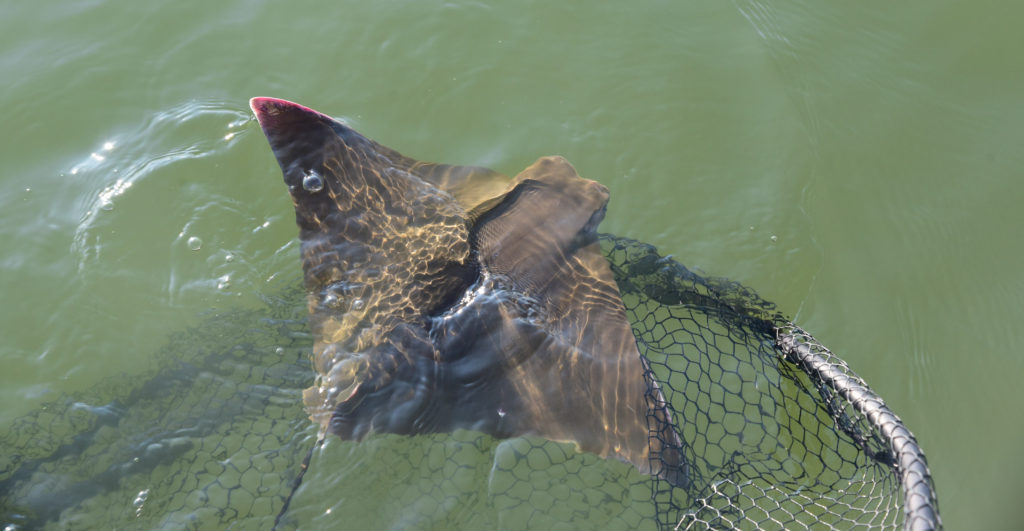by Kristen Minogue
Every summer, cownose rays stream into Chesapeake Bay to mate and give birth to their pups. When autumn comes, they disappear—presumably to migrate south, but no one knew for certain where they spent the winter. Now, after a three-year tagging study published Aug. 23 and led by the Smithsonian Environmental Research Center (SERC), scientists have solved the mystery. Cownose rays all along the Atlantic winter near Cape Canaveral, Florida, and it’s likely they return to the same spots each summer.
Cownose rays are large stingrays native to the Chesapeake, with dark brown or olive-gray backs and white bellies. They reproduce slowly. Most mothers give birth to only one pup a year, and don’t mature until age seven or eight, making them vulnerable to intense fishing or sudden population declines. And yet cownose rays have been dogged by controversy. In the early 2000s they were saddled with partial blame for oyster declines because their diet includes shellfish. (Later studies cleared their names. Oysters had been declining years before cownose rays became more abundant, and oysters make up only a small percent of their diets. Though rays sometimes have taken advantage of unprotected juvenile oysters planted to restore reefs, in general they prefer weaker bivalves like soft-shell clams.) Later, in 2015, bowfishing tournaments for cownose rays began raising alarm among some Marylanders. In response, the Maryland government voted to become the first state to create a fishery management plan to conserve the cownose ray.
“Because of the slow birth rate, we know that if we don’t manage them, and instead harvest them in a way that heavily impacts the population and causes a population decline, it’ll take a long time for them to recover,” said Matt Ogburn, SERC marine biologist and lead author of the study. “If we lose something important, we could lose it for decades.”

SERC marine ecologist Matt Ogburn (front) and intern Claire Mueller search for bull sharks and cownose rays near Fort Pierce, Florida, in January 2018. (Credit: Jay Fleming/Smithsonian)
The new study, published in Marine Ecology Progress Series, marks the first time scientists have tracked cownose ray migrations along the Atlantic coast for a full year or more. Knowing where they go every year will help fill in some longstanding knowledge gaps about the rays, as Maryland officials decide how to manage them. It’s part of the Smithsonian Institution’s new Movement of Life Initiative. Scientists from the Virginia Institute of Marine Science (VIMS) and Savannah State University also joined the effort.

Bob Fisher, a biologist with the Virginia Institute of Marine Science, releases a tagged cownose ray into the water. (Credit: Sayer Fisher)
To tag the rays, scientists spent three summer-fall field seasons teaming up with commercial fishers. These fishers were not trying to catch cownose rays, but the animals often appear as accidental bycatch in their pound nets or haul seines. Many of the fishers had worked with the scientists before, partnering with VIMS co-author Bob Fisher or on SERC’s crab tagging studies.
“Collaborative efforts with commercial fishers are built on trust, straight talk, and inclusion to investigate common problems and opportunities,” said Fisher, who has studied cownose rays for nearly three decades.
After transferring the rays to a holding tank, the researchers gave them general and local anesthesia and inserted a small acoustic tag inside them. Once the rays had recovered from surgery, the scientists released them back into the water. As the rays continued their journeys, the tags emitted a series of “pings” unique to each ray. An array of hundreds of receivers lines the Chesapeake and the Atlantic coast, waiting to pick up their signal. These receivers were placed by dozens of scientists from institutions along the East Coast, all sharing data on different species. If a ray passed within half a kilometer of a receiver, the receiver would record data about the ray’s location. Then the data were shared through the Atlantic Cooperative Telemetry Network and Florida Atlantic Coast Telemetry Network.
The teams tagged 42 rays total. Most they tagged in Virginia, with five in Maryland and two in Georgia. Of those rays, 28 had their signals detected multiple times over a period longer than 90 days, enough time for scientists to get a sense of their migration behavior.
Regardless of where scientists tagged the rays, every ray they detected in winter went to the same spot: a region just off the coast of Cape Canaveral, Florida. The greater challenge was figuring out if cownose rays go back to the same places each summer. While most rays returned to the same regions where scientists tagged them the previous year—some even to the same rivers—many rays were tagged in the fall, when they might have already left their summer homes. Only five rays sent out location signals for both summer 2015 and summer 2016. Four of those rays (three from Virginia and one from Georgia) returned to their original regions. The fifth spent both summers in the Chesapeake, but the first summer in Virginia and the second in Maryland.

Scientists release a tagged cownose ray into the water. (Credit: Jay Fleming/Smithsonian)
This pattern could make conservation even more critical. If cownose rays are returning to the same places each summer, that means the Chesapeake likely has its own distinct population. Intense fishing of rays in the Chesapeake, especially during summer, could wipe out a large slice of the species’ genetic diversity.
“If they’re really tied to one specific place, then you’ll be removing a whole piece, a whole unique segment, from the population,” Ogburn said.
While scientists have unraveled one mystery about cownose ray migrations, there are still many unknowns surrounding the animals. Not least, the authors emphasized, is their role in the Chesapeake Bay as a whole. By turning over the sediment, a bit like tilling a garden, they could play a vital role for organisms like shellfish and crabs that live on the Bay floor. As Maryland develops the first official management plan for cownose rays, studies like this will offer more guidance on how to manage one of the most enigmatic creatures in the Chesapeake.
Learn more:
Tracking the Bay’s Cownose Rays
Following the Movement of Life: Tagging Sharks and Rays


I love it so much